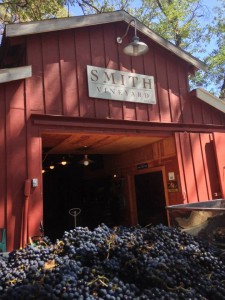Vintners predict quality wines from grape harvest
 THIS YEAR’S WINE GRAPE HARVEST began early. Deploying little more than a pair of well-sharpened shears, the vintners, laborers and volunteers fanned out into the vineyard, hand harvested the grapes, put them in bins (or lugs) and hauled them off to the winery on a big tractor.
THIS YEAR’S WINE GRAPE HARVEST began early. Deploying little more than a pair of well-sharpened shears, the vintners, laborers and volunteers fanned out into the vineyard, hand harvested the grapes, put them in bins (or lugs) and hauled them off to the winery on a big tractor.
The freshly picked grapes were sorted for quality, crushed and destemmed and left to ferment. (Machines have replaced the foot stomping). Harvest is continuing into October, when the last Cabernet Sauvignon grape is picked.
Sometimes a winery dog tagged along. And yes, some local craft beer was consumed along the way.
The vintners tell us the harvest yielded high-quality grapes, so we can expect some great tasting wines in the New Year and beyond.
This year’s vintage had raised some concerns, thanks to the ongoing drought, the threat of rain during harvest, too many varietals ripening at once, and even an earthquake in the Napa Valley.
But the weather largely held steady, the workers hustled, and the vines remained healthy.
The tonnage is down at some vineyards, but “quality over quantity” sums up the harvest for most growers.
At Naggiar Vineyards, the vines held about four to ten pounds of fruit per vine. “The berries are Goldilocks size—not too big, not too small but just right,” summed up winemaker Derek Irwin. (About 2.8 pounds of grapes are used to make a bottle of wine).
At Pilot Peak Winery, winemaker Lynn Wilson was happy with the vintage, including the Syrah, which typically is exceptional anyway. That’s an optimistic sign.
Other vintners agreed. “It was a beautiful growing season this year,” added Jackson Starr, winemaker and vineyard manager at Sierra Starr.
“The flavors are amazing,” said Smith Vineyard owner-winemaker Gary Smith as he and the crew harvested the winery’s popular Chardonnay vintage, joined by their faithful winery dog, Ruger.
Other winemakers agreed, including Mark Henry of Montoliva and Jacques Mercier of Solune, whose wineries are on one of our featured road trips.
Placer County vintners also were pleased with the quality of this year’s harvest. PaZa Winery staff, some friends and wine-club members foot stomped some grapes for a good time after harvest. But they left the real work to an automatic crusher-destemmer.
Other regions, including Napa and Sonoma counties, also are optimistic about the harvest. Some winemakers think this year’s vintage could be better than last year’s.
Steps of Winemaking
Harvest:
Harvest in California usually begins in late August to early September and may last through November, depending on the weather and the grapes.
Crush:
After harvest, grapes are placed in a destemmer-crusher, which separates the stems from the fruit and breaks up the berries. The stems are then discarded leaving the “must,” a combination of juice, seeds, pulp and skins. Grape skins are what give red wine its color, flavor and “tannins” – the polyphenols that enable red wines to take on more complexity as they age.
Fermentation:
Yeast is added to the juice to begin fermentation, the process by which the natural sugars convert to alcohol. Wines may be fermented or aged in oak or stainless steel barrels, or both. Fermentation lasts anywhere from three days to three weeks, depending on the wine.
Wines can be aged in stainless steel or oak barrels. It is common for red wines to be aged in oak barrels for one to two years. White wine is aged anywhere from one week to a year.
Finishing:
Finally the wine undergoes finishing, a process by which the wine is stabilized and filtered before bottling.
(Photo: Chris Smith, Smith Vineyard)
